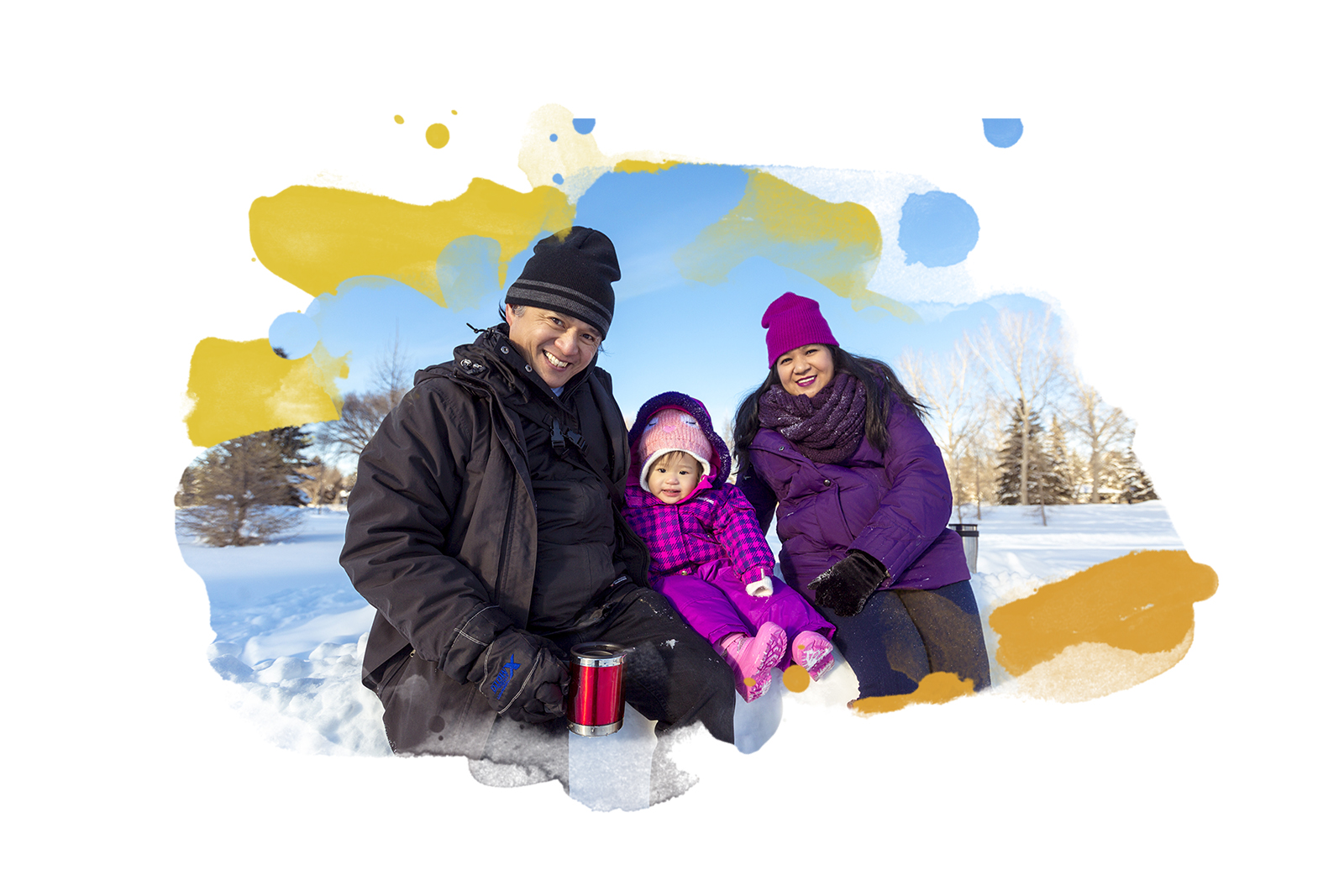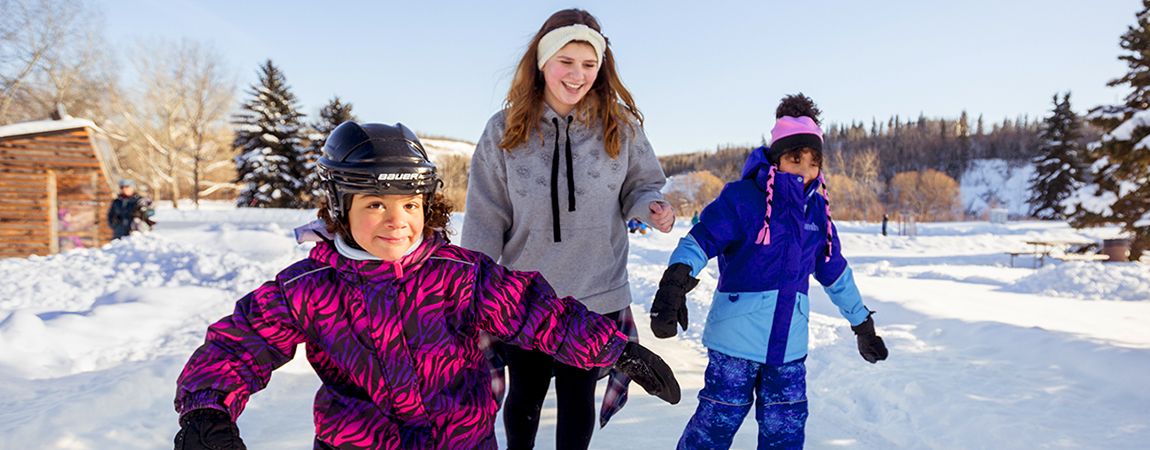Keeping warm and dry is the key to winter fun. Here are some tips and tricks for dressing to make your outdoor winter experience the best it can be.
Necessities
Toque, mittens, warm socks, and winter boots are a must! A scarf or neck warmer tube are also important to keep the heat from escaping out of your jacket.
Layers, Layers, Layers!
In winter, the best way to dress is in layers. This will let you adjust to how warm or cool you get while playing outside. It’s a good idea to take an extra layer with you, too, when you head out for the day, just in case you need it. Here’s the best combination for staying warm and dry when you head outside for winter activities.
Base Layer
This is sometimes called a wicking layer because it should wick, or pull, moisture away from your skin. Without this layer, you’ll get wet when you sweat, and you’ll get cold. This is the first layer, next to your skin…think long johns! The best materials for this layer are wool (merino wool is soft and warm), silk, and synthetic materials such as nylon, polyester, or polyester blend.
Mid-Layer
Also called the insulating layer because it should keep you warm. Wool and fleece sweaters, a light down jacket, and fleece pants are all good choices. Snow/ski pants also work, and they do double-duty as a wind-blocking layer.
Outer Layer
The last layer, sometimes also called a shell. This layer should protect you from the wind and snow to keep you warm and dry. It should be breathable, but water-resistant or waterproof. Gore-tex is possibly the best-known material for this layer, but there are many good alternatives, too.
Keeping Dry
Keeping dry is really important in the winter! If your clothing gets wet, you’ll get cold very quickly. Winter boots and outer clothing should be water-resistant or waterproof. If your boots don’t come up your legs very far and you’re going in deep snow, put on some gaiters to keep the snow out of your boots.
If you’ll be outside for several hours, especially if you’re heading out on cross-country ski trails or for a hike, pack extra clothing like a sweater, socks and mitts.

Best Materials to Keep You Warm and Dry
Wool, silk, down, and synthetic fabrics are the best. There are pros and cons to all materials, and they’re available in different price ranges. Check with your local outdoor store for advice to see which materials would be the best for your activities. Remember that you can find good used outdoor clothing in Edmonton, too.
What Not to Wear
Cotton and linen are not good choices for winter wear. Both fabrics lose heat quickly and will not keep you warm.
No jeans! Jeans are the worst type of pants to wear in the snow. The heavy cotton will get wet quickly and will sometimes even freeze while you’re wearing them!
To find other handy tips as well as links to our winter fashion make-over videos see our Winter Fashion page.
Tips for Dressing Kids
Dress kids so that they can play in the snow and stay warm and dry. See the Layers! Layers! Layers! section above for some ideas. Here are some other time-tested tricks for getting kids dressed in the winter.
Mittens or Gloves?
Mittens are usually warmer than gloves and are easier to put on little hands. Whichever you choose, put them on before the jacket – this is the easiest way to tuck them into the jacket sleeves.
Neck Warmer or Scarf?
Both will keep kids’ necks warm, but tube neck warmers slip over kids’ heads easily and don’t have loose ends that can get caught while playing or come undone. Put the neck warmer on before the jacket, too, to keep it tucked in.
Snow Pants Gaiters
Most snow pants have a built-in gaiter at the bottom of the pant legs – it looks like a cuff with elastic at the bottom. Pull this over the boots to keep snow out of the boots and pant legs. Some gaiters even have a hook that you can attach to boot laces to keep them in place.
Snowsuit: One-Piece or Two?
There are pros and cons to both! A one-piece snowsuit is easy to put on, and cold air and snow don’t go up the jacket. But, it’s not as versatile as snow pants and a jacket, especially if you go inside for a snack – or a bathroom break. With a two-piece suit, the jacket can be removed easily while the snow pants and boots can be left on. Some parents find the one-piece suits easier for little kids, then switch to a two-piece when the kids get older.
Other Handy Items
Sunglasses
On sunny days, the sun reflects off the snow, giving your eyes a double-whammy of sunshine. Protect your eyes with good sunglasses.
Cleats
Cleats can be attached to your footwear to help grip the ice when you walk. There are many styles, so have a look around to find a pair that fits your boots and that you can get on and off fairly easily. Before venturing out, think about if you will need to take them off when you get where you’re going. Remember, they’ll be wet, so take a bag to put them in.
Gaiters
Gaiters are basically a tube that goes over your boots, usually up to your knees. These handy pieces of clothing keep snow out of your boots, especially if your boots are short.
Headlamp
It gets dark early in winter. If you’re going to be outside after dark, a headlamp might come in handy. You’ll still be able to walk, cross-country ski, or snowshoe while having your hands free.
Reflective Gear
Much of our winter clothing is dark. If you’re going outside after dark, a bit of reflective striping will help others see you better, whether you’re on the trail or a sidewalk.
